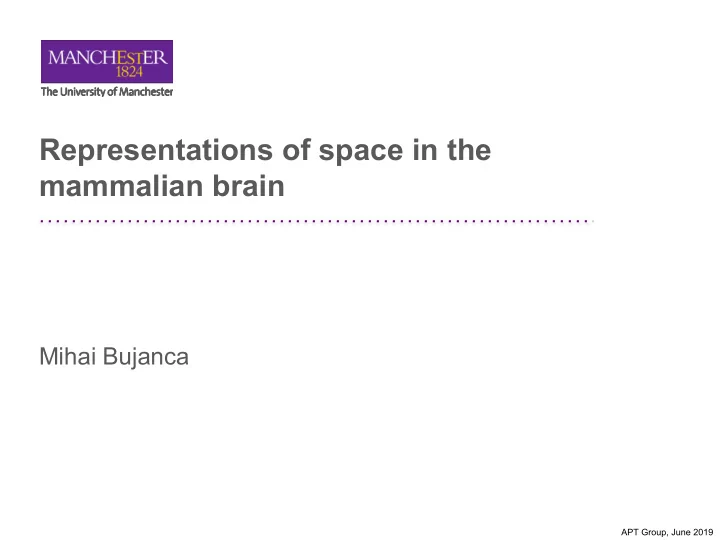

Representations of space in the mammalian brain Mihai Bujanca APT Group, June 2019
Ivan Pavlov: classical conditioning Initially discovered that dogs started to salivate when hearing the footsteps of the assistant who was feeding the dogs. Theorised that a type of association is being made between stimuli.
Behaviourism: John Watson “Give me a dozen healthy infants, well-formed, and my own specified world to bring them up in and I'll guarantee to take any one at random and train him to become any type of specialist I might select – doctor, lawyer, artist, merchant-chief and, yes, even beggar-man and thief, regardless of his talents, penchants, tendencies, abilities, vocations, and race of his ancestors.” (Behaviorism, 1924) “ I am going beyond my facts and I admit it, but so have the advocates of the contrary and they have been doing it for many thousands of years.”
Operant conditioning: B.F Skinner Introduces the idea of reinforcement by positive and negative stimuli. Skinner Box: mechanism to provide negative and positive reinforcement
Edward C. Toleman “We believe that in the course of learning something like a field map of the environment gets established in the rat's brain. We agree with the other school that the rat in running a maze is exposed to stimuli and is finally led as a result of these stimuli to the responses which actually occur. We feel, however, that the intervening brain processes are more complicated, more patterned and often, pragmatically speaking, more autonomous than do the stimulus-response psychologists. Although we admit that the rat is bombarded by stimuli, we hold that his nervous system is surprisingly selective as to which of these stimuli it will let in at any given time. Secondly, we assert that the central office itself is far more like a map control room than it is like an old fashioned telephone exchange. The stimuli, which are allowed in, are not connected by just simple one-to-one switches to the outgoing responses. Rather, the incoming impulses are usually worked over and elaborated in the central control room into a tentative, cognitive-like map of the environment. And it is this tentative map, indicating routes and paths and environmental relationships, which finally determines what responses, if any, the animal will finally release“ Cognitive maps in rats and men (E.C. Toleman, 1948)
Patient HM, 1950 ● Severe epilepsy originating in the medial temporal lobes on both sides of his brain ● Opted to have the majority of his hippocampus, entorhinal cortex and amygdala removed ● Surgery successful, patient remembers nothing! Anterograde amnesia, H.M couldn’t form new declarative memories. https://en.wikipedia.org/wiki/Henry_Molaison
The Hippocampus https://en.wikipedia.org/wiki/Hippocampus
John O’Keefe Decided to study memory by implanting electrodes in the rat hippocampus. Previously, rats couldn’t move around freely while the electrodes were connected. The hippocampus as a spatial map. Preliminary evidence from unit activity in the freely-moving rat (O’Keefe and Dostrovsky, 1971, Brain Research) Place units in the hippocampus of the freely moving rat (O’Keefe, 1976, Experimental Neurology)
Place cells in CA1 The place-cell representation of volumetric space in rats (Grieves et al. 2020, Nature Communications)
Just place cells? Predictions: • Speed cells • Head direction cells • Boundary cells • Distance cells The hippocampus as a cognitive map (O’Keefe and Nadel, 1978)
Head direction cells Head-direction Cells Recorded From the Postsubiculum in Freely Moving Rats. I. Description and Quantitative Analysis (Taube et al. 1990, Journal of Neuroscience) Head-direction Cells Recorded From the Postsubiculum in Freely Moving Rats. II. Effects of Environmental Manipulations (Taube et al. 1990, Journal of Neuroscience)
Speed cells Speed cells in the medial entorhinal cortex(Kropff et al. 2015, Nature)
Boundary (border) cells Predictions derived from modelling the hippocampal role in navigation (Burgess et al. 2000, Biological Cybernetics) Modeling place fields in terms of the cortical inputs to the hippocampus (Hartley et al. 2000, Hippocampus) The boundary vector cell model of place cell firing and spatial memory (Barry et al. 2006, Nature Reviews Neuroscience)
Distance cells? 1995 postdocs with O’Keefe, learned the methods for inserting electrodes to read from single neurons. Established a new lab in Trondheim and started studying navigation, starting from the hippocampus. May-Britt and Edvard Moser
Grid cells! Spatial Representation in the Entorhinal Cortex (Fyhn et al. 2004, Science) Grid cells in mice (Fyhn et al. 2008, Hippocampus)
Fragmentation of Grid Cell Maps in a Multicompartment Environment (Derdikman et al. 2009, Nature)
Grid cells respond to different scales Microstructure of a spatial map in the entorhinal cortex (Hafting et al. 2005, Nature)
3D navigation: bats 3D Hippocampal Place Field Dynamics in Free-Flying Echolocating Bats (Wohlgemuth et al, 2018)
RatSLAM: what about robots? OpenRatSLAM: an open source brain-based SLAM system (Ball et. al, 2013, Autonomous Robots) RatSLAM: a hippocampal model for simultaneous localization and mapping (Milford et. al, 2004, ICRA)
Not just navigation? “Grid cells are thought to provide the neuronal code that underlies spatial knowledge in the brain. Grid cells have mostly been studied in the context of path integration. However, recent theoretical studies have suggested that they may have a broader role in the organization of general knowledge. Constantinescu et al. investigated whether the neural representation of concepts follows a structure similar to the representation of space in the entorhinal cortex. Several brain regions, including the entorhinal cortex and the ventromedial prefrontal cortex, showed gridlike neural representation of conceptual space.” Science , this issue p. 1464 Organizing conceptual knowledge in humans with a gridlike code (Constantinescu et. al, 2016, Science)
Navigating conceptual spaces Neural mechanisms underlying advanced cognition in humans (Alexandra O. Constantinescu, 2017, PhD Thesis)
Navigating to think Neural Ensembles in CA3 Transiently Encode Paths Forward of the Animal at a Decision Point (Johnson et. al, 2007, Journal of Neuroscience)
Thanks
Recommend
More recommend